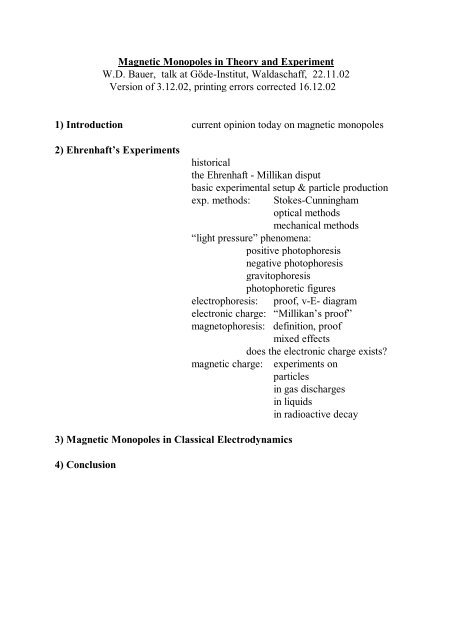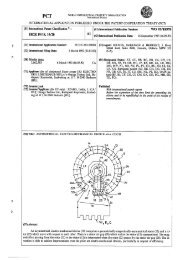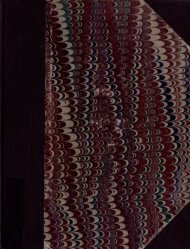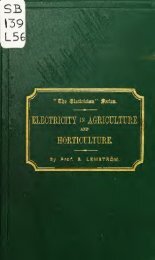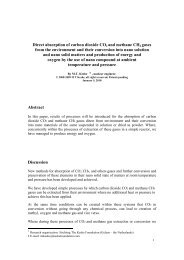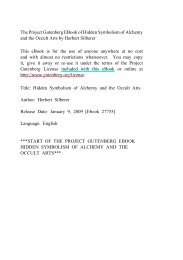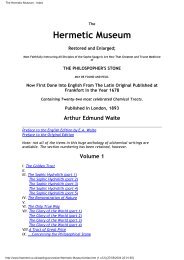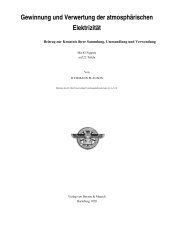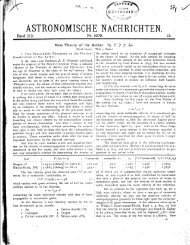Create successful ePaper yourself
Turn your PDF publications into a flip-book with our unique Google optimized e-Paper software.
<strong>Magnetic</strong> <strong>Monopoles</strong> in Theory and Experiment<br />
W.D. Bauer, talk at Göde-Institut, Waldaschaff, 22.11.02<br />
Version of 3.12.02, printing errors corrected 16.12.02<br />
1) Introduction current opinion today on magnetic monopoles<br />
2) Ehrenhaft’s Experiments<br />
historical<br />
the Ehrenhaft - Millikan disput<br />
basic experimental setup & particle production<br />
exp. methods: Stokes-Cunningham<br />
optical methods<br />
mechanical methods<br />
“light pressure” phenomena:<br />
positive photophoresis<br />
negative photophoresis<br />
gravitophoresis<br />
photophoretic figures<br />
electrophoresis: proof, v-E- diagram<br />
electronic charge: “Millikan’s proof”<br />
magnetophoresis: definition, proof<br />
mixed effects<br />
does the electronic charge exists?<br />
magnetic charge: experiments on<br />
particles<br />
in gas discharges<br />
in liquids<br />
in radioactive decay<br />
3) <strong>Magnetic</strong> <strong>Monopoles</strong> in Classical Electrodynamics<br />
4) Conclusion
1. Introduction<br />
The current scientific opinion says:<br />
experimentally:<br />
there exist no significant proofs on<br />
magnetic monopole charges<br />
theoretically:<br />
1) magnetic monopoles behave acc. to Dirac’s<br />
prediction, i.e.<br />
de facto:<br />
ge ¡ n<br />
c 2<br />
2) electric and magnetic fields have the<br />
following symmetries:<br />
x --> -x E -1<br />
D -1<br />
H 1<br />
B 1<br />
t --> -t E 1<br />
D 1<br />
H -1<br />
B -1<br />
experimentally:<br />
magnetic monopoles were found<br />
and seem to follow Dirac’s prediction<br />
theoretically:<br />
therefore, electromagnetic fields do not have<br />
any symmetric preferences generally<br />
practically and economically:<br />
relevant with respect to calculation and design<br />
of anisotropic magnetic materials and antennas
2. The Experiments of Felix Ehrenhaft<br />
historical problem: how to measure forces on little particles ?<br />
to test the theories of<br />
light pressure<br />
electronic or magnetic charges<br />
typical experimental setup:<br />
Ehrenhaft’s basic setup to observe aerosols<br />
1) DC-current lampe 20-25 A, 2) iris tube, 3) convex lens 36mm, f=50mm, 4) projective objektiv f=80mm,<br />
5) water filter, 6) shutter, 7) wire release, 8) projective lens f=55mm, 9) stative for illuminatig objektive,<br />
10) micrometer screw for horizontal movement in beam direction, 11) micrometer screw for horizontal movement perpendicular to the<br />
beam direction, 12) micrometer screw for adjustement in height, 13) illuminating objective f= 17mm num apert. 0,3, 14) microskope<br />
for observation; objektive; f= 17mm num apert. 0,3, compensatin okular 12 Zeiss , 15) probe chamber (as Kondensator) comp.<br />
Abb.2, 16) to pump 17) +18) to pump, 19) taps to gas inlet and outlet 20) rails of optical bank<br />
cross section of the chamber of Ehrenhaft’s setup, vgl. fig.<br />
above<br />
view of the chamber under the microscope<br />
arrow shows the direction od the light beam, the lines represent<br />
light-positive and light-negative particles<br />
production of particles: by electrical sparking of the wanted material
method is indirect and needs<br />
Measuring Forces on Microscopic Particles<br />
1) a measurement of the velocity of the particle<br />
2) a measurement of the diameter of the particle<br />
formulas:<br />
and<br />
measurement of velocity :<br />
F 6 ¡ ¢ v 1 £<br />
v µ.F<br />
1.63 l/r<br />
f £ 2(1 ¤ f)<br />
with<br />
with<br />
v: velocity<br />
µ: mobility<br />
F: force<br />
¢<br />
: viscosity<br />
f : 0 (elastic recoils)<br />
l: free mean path<br />
r: radius<br />
with microscope scale und stop watch<br />
measurement of diameter (selection!):<br />
using Mie-light diffraction<br />
by a mechanic method<br />
by fotography
Results of Experiments with Light Pressure<br />
1) Einstein’s formel is wrong for high light intensities;<br />
values of µ determined acc. to Einstein are to high<br />
if compared with other methods applied by Ehrenhaft<br />
µ Ehrenhaft
4) the path is spiraling, if<br />
particle diameter > wavelenght ¡<br />
5) there exists “Gravitophoresis” i.e.<br />
some particles move in the light beam against gravity<br />
Gravitophoresis: the particles seem to loose their weight and are hanging at the upper border of the illuminating light beam.<br />
sometimes they are moving up and down periodically; comp. left fig.
6) There exist highly complex “photophoretic” patterns of movements<br />
Setup:<br />
vacuum bulb to observe photophoresis<br />
a filamentl b vacuum c anode f dust material<br />
g to pumping line h deflection electrode<br />
Conditions: 10 -5 -> 50 mg Hg pressure ,<br />
intensive (sun)-light has to be focused by a big lens<br />
( =10-20cm ) in the inner of the vacuum bulb<br />
A fine dust matrial ( =10 -3 cm) has to be used<br />
typical “nice” pictures:<br />
complex patterns of movement in photophoresis as taken as snapshots with stroboboscobe illumination (positives)
The most important patterns of photophoresis<br />
photophoretic toroidal path the most important toroids of photophoresis, comp. text<br />
the particles are captured in the gradient of the light focus and move<br />
on a stable and closed path!<br />
photophoretic toroid during a day frequency measurement of photophoretic<br />
toroids during a day
Electrophoresis<br />
Definition: movement of charged particles in a electric field. the charge is<br />
generated by intense light. it dissapears instantaneously if the light is<br />
switched off<br />
Observations: 1) the movement of the particle commutes with the field<br />
(in the most cases !)<br />
velocity v vs. electrical field E of a electrophoretic charged<br />
particle. the saturation depends from the intensity<br />
2) the stronger the light, the bigger the effect<br />
3) electrophoretic charges go down to 1/10 e.<br />
4) Electrophoresis shifts the position of<br />
photophoretic toroids in a light focus<br />
5) the effects are not influenced by ionising<br />
radiation ( - oder UV-Strahlung)<br />
6) useful materials ordered : Te, Sb, J > Ni, Fe, Se, Bi<br />
7) it exists a optimal gas pressure<br />
8) the saturation field of a particle is<br />
independent from pressure<br />
velocity v vs. lamp current for a<br />
Sb -Particle under electrophoresis
The electric Charge<br />
Historical background: Ehrenhaft-Millikan disput:<br />
Millikan stated to have seen e<br />
Ehrenhaft said that this is not possible !<br />
today we know : Ehrenhaft was right - Millikan tuned his data !<br />
Experimental setup:<br />
Measurements:<br />
without field: mg v 1 /µ<br />
¡ ¢<br />
¢ ¢<br />
with negative field: eE mg v2 /µ<br />
with positive field: eE mg v3 /µ<br />
after measurement the equations are solved for µ, m und e<br />
Conclusion: the single electronic charge cannot be proved at this<br />
pressures with this method.<br />
histogramm of 74 charged oildrops from a student lab.<br />
From:.American Journal of Physics 40 (May 1972), 769<br />
1/3-electronic charges on little supraconductive Niob spheres<br />
measured acc. to Fairbank’s method
Magnetophoresis<br />
Definition: movement of magnetic charged particles in a magnetic field. The<br />
magnetic charge is induced by the light and disappears<br />
instantaneously , if the light is swichted off.<br />
Experimental setup:<br />
Observations: 1) magnetophoresis adds to photophoresis in the light<br />
2) the particle follow the outer field acc. to unipolar charge<br />
They can be deviated by a homogeneous magnetic field.<br />
experimental setups to observe magnetophoresis The path on the left represents a monopol
Observations:<br />
1) linear or weak spiraling<br />
movements enlarge<br />
to full spiral in field.<br />
kinetic energy or velocity<br />
remains conserved.<br />
2) the v-H diagrams are pointsymmetric.<br />
The form of the<br />
Diagrams varies very strongly<br />
3) it exists a fixed ratio<br />
q H/q E which is empirical<br />
q H<br />
q E<br />
E v ¡ H<br />
H vE Dirac ¢ value<br />
experiment of V.F. Mikhailov<br />
parallel velocity distribution of elektrophoretic ( E) and<br />
magnetophoretic (M) charged particles<br />
different v-H- diagrams of magnetophoresis;<br />
linear v-H -diagram at weak H-field<br />
different v-H- diagrams of magnetophoresis;<br />
saturation at high H-field<br />
different v-H- diagrams of magnetophoresis;<br />
a possible v-H -diagram<br />
different v-H- diagrams of magnetophoresis;<br />
a possible v-H -diagram<br />
different v-H- diagrams of magnetophoresis;<br />
a possible v-H -diagram
Setup:<br />
Fall experiment under stroboscobe<br />
illumination<br />
Observations:<br />
1) particles fall with a screw<br />
movement without any electric<br />
charge<br />
2) after switching on the field the<br />
particles jump around some<br />
seconds.<br />
–> Barkhausen - noise ????<br />
The magnetic Charge<br />
Setup to observe falling particles in magnetic fields;<br />
B channel, Z chamber of glass G rubber tightenings<br />
left fig.15a and b falling copper paticles in the magnetic field (7000 G) in 15b screwing path with =1/8mm and slope per tread 1.4<br />
oder 0.6mm; fig.16 right side: explosion of Nickel particles on switching in 7000 Gauss under stroboscobic Illumination.
3) “classical” monopoles under stroboscobe illumination<br />
free fall of a particle (Fe or Cr) in the field without monopole<br />
charge under stroboscobe illumination<br />
4) bursting of particle into magnetic monopoles<br />
with conservation of momentum and charge<br />
<strong>Magnetic</strong> burst of a particle with magnetic charge; left hand before, right hand after the burst<br />
free fall of a particle (Fe or Cr) in the field with monopole charge<br />
under stroboscobe illumination
<strong>Monopoles</strong> in different environments<br />
1) in light: magnetisation of iron by light is observed!<br />
magnetisation explained by charging up with monopoles ?<br />
2) in gas discharges: all magnetic charge particles are produced in sparks !<br />
3) in vacuum tubes: a) Righi’s magnetic rays<br />
setup: magnet in vacuum as cathode<br />
surface covered by with apiezon grease<br />
anode in space, 800V, 40mA, R=50000<br />
setup for observation “magnetic” rays<br />
1 glass vessel, 2 glass window, 3 stopper, 5+7 anode, 4 cathode, 6 to pumping lines 8 magnetic cathode
Observations: 1) el. fields do not influence the radiation<br />
2) light intensity ~ magnetic field<br />
3) rays go through Alu if in magnetic field<br />
4) rays originate from apiezon grease<br />
magnetic rays in different field geometries of the magnetic field<br />
foto of magnetic rays with a separated cathode in setup (right<br />
side)<br />
5) plasma can be decomposed, however<br />
no exact results were available.<br />
6) magn. rays not present in high vacuum<br />
sceme to clarify the left foto<br />
a) spiral wave b) diffuse rays c) “neutral beaml”
3) in vacuum tubes: b) Tesla’s oscillating plasma files<br />
Observations:<br />
at 10000Hz, and high voltage in a gas discharge - 1 plasma file<br />
with additional magnetic field - splitting up in 2 files,<br />
Oscillation after disturbance by magnetic fields or by approach of a hand<br />
Interpretation( acc. to Freeman Cope): plasma file consists of monopoles<br />
4) charged solid bodies with monopoles ? (experiment of Freeman Cope)<br />
Measurement of the (superweak) magnetic fields of hairs<br />
white hair | black hair<br />
-----------------------------------------------|--------------------------------------at<br />
protonresonanzmagnetometer |<br />
2 | 2<br />
-----------------------------------------------|--------------------------------------at<br />
SQUID<br />
8 | 2
5) <strong>Monopoles</strong> in Liquids ?<br />
“Charging” experiments or only<br />
slowly changes of chemical substances in a magnetic field ???<br />
solution von Oxygen in water<br />
in a magnetic field<br />
change of the spectrum of absorption<br />
of Trypsin a magnetic-field<br />
change of the spectrum of absorptions<br />
of water under a magnetic field<br />
solution of O 2 in H 20 in a magnetic field; 1 near to the magnetic<br />
pole after switching on; 2 dito after switching off the field<br />
absorption of Trypsin vs. wavelenght after a “treatment” of<br />
8000 Oe; I control; II 2h; III 5h; IV 7h<br />
absorption of flowing H 2O vs. wavelenght at different magnetic<br />
fields
change of viscosity of water in<br />
magnetic field<br />
change of electric resistance of water<br />
in a magnetic field<br />
change of surface tension of water in<br />
magnetic field<br />
viskosity of H2O in a magnetic field<br />
electric resistance of water in a magnetic field<br />
electric surface tension of water in a magnetic field<br />
change of cristallites in water in a magnetic field<br />
a similar phaenomen: different cristal modifications in water before and after a “vortex treatment”
6) fields of movement in liquids by magnetic field<br />
FeCl - solution in a field of a magnet<br />
shows a rotation. the direction of<br />
rotation depends, whether the solution<br />
is acid or a base<br />
–> experiment (base over acid or reverse)<br />
Reagents:<br />
HCl(6n) HCl(6n) HCl(6n) HNO3(6n) H3PO4(6n)<br />
NaOH(6n) NH4OH(6n) KOH(6n) KOH(6n) KOH(6n)<br />
NH4OH(6n) NaOH(6n) KOH(6n) NH4OH(6n) NH4OH(6n)<br />
CH3COOH HJ(6.9n) HJ(6.9n) H2SO4(6n) H2SO4(6n)<br />
Setup:<br />
Petri disks are positioned over magnets !<br />
Observations:<br />
if acid is positioned over the base there arise rotations of the liquid,<br />
whose direction of rotation depends from the pH locally present<br />
for a rotation is necessary:<br />
1) a vertical gradient in acidity 2) a magnetic field<br />
a temperature gradient can reverse the direction of rotation<br />
without magnetic field there exist no effect<br />
a semipermeable membran between base und acid does not prevent<br />
the effect!
7) magnetic monopoles in radioactive phaenomena ?<br />
blackening of photoplates bei -Strahlern is intensified,<br />
if they are in a magnetic field .<br />
Interpretation: particles carry magnetic charges<br />
and are accelerated by the field<br />
setup to prove the enhancement of radioactive radiation by magnetic fields
Consequences:<br />
§<br />
§<br />
§<br />
§<br />
§<br />
§<br />
§<br />
3.) <strong>Magnetic</strong> <strong>Monopoles</strong> in Classical Electrodynamics<br />
<strong>Magnetic</strong> monopole charges are necessary,<br />
because<br />
divB div(µ(x).H) µ divH ¡ H grad µ(x) ¢ 0<br />
magnetic fields are general fields without parity properties<br />
the causes of fields are always current and charges<br />
the magnetic boundary conditions have to be modified<br />
Constitutive relations are generally<br />
¤ ££<br />
££<br />
D ££B<br />
f (E,D,H,B;T,¥ 1 i<br />
f (E,D,H,B;T,¥ 2 i<br />
f (E,D,H,B;T,¥ 3 i<br />
,...)(x,t) ,x,¦<br />
,...)(x,t) ,x,¦<br />
,....)(x,t) ,x,¦<br />
--> In order to solve the problem the PDE-System of Maxwell<br />
equations has to be completed by thermodynamic, mechanic and<br />
other PDE -equations from the other areas of physics<br />
old magnetic vector potential A alone does not work generally !<br />
–> general magnetic fields have to be be derived from a vector<br />
potential and a magnetic potential due to magnetic charges<br />
practical applications: antenna with anisotropic cores<br />
simulation of and with permanent magnets
4.) Conclusion<br />
Electromagnetic forces may have some interesting, unexploited features as<br />
negative photophoresis<br />
gravitophoresis<br />
photophoretic figures<br />
spiral movement<br />
magnetophoresis<br />
magnetic monopoles<br />
magnetic monopoles seem to be necessary even in conventional electric<br />
engineering to cover all cases in magnetic field calculations<br />
magnetic effects can play a big role in chemistry


